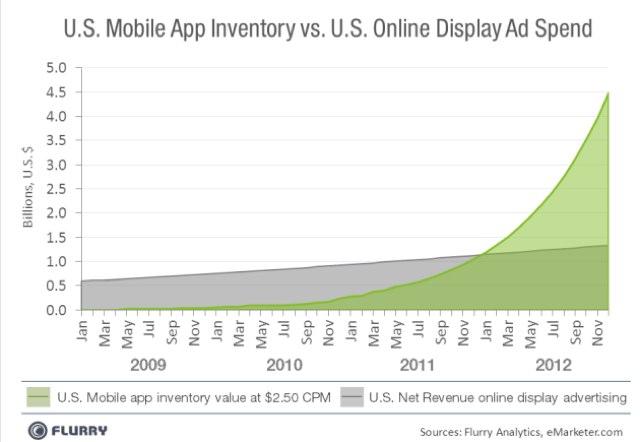With more than 600,000 apps available for an estimated 350 million Apple and Android mobile devices, it’s not difficult to see how mobile app advertising could soon eclipse online display advertising. In fact, app analytics company Flurry put this chart together to show how mobile app inventory is growing so fast that it could absorb all of the money spent on online display ads by the end of the year. Now, just because there is enough mobile app ad inventory to absorb that spending doesn’t mean it will, but the chart does show the potential of mobile app advertising.
How did Flurry come up with these numbers? The mobile app analytics company drew on its own data, which it tracks across 100,000 mobile apps, and extrapolated from there. It found that the average app session is 4.2 minutes, and 4.3 ads are shown per session. Flurry applied those numbers to the entire mobile app market, and assumed a $2.50 average CPM (cost per 1000 impressions). It plugged in its assumptions about mobile app ad impression growth and, presto, it came up with the chart above, which shows mobile ad spending theoretically catching up with the $1 billion a month spend on display ads by the end of the year, and growing to $4.5 billion a month by the end of 2012.
I say “theoretically” because these estimates assume that all of that mobile ad inventory will be filled at $2.50 CPM. In fact, a very large portion of mobile ad inventory goes unfilled. So this is partly wishful thinking on the part of the mobile app industry, but it does show the potential of mobile app advertising. If only mobile ad networks could fill all of those ad slots.
To put this in perspective, estimates of actual mobile ad revenues in the U.S range from $700 million (Gartner) to $1.1 billion (eMarketer) for 2011. Online Display in the U.S. will be about $12 billion. So the industry would need to see a 12-fold increase in actual dollars spent in order for mobile to catch up with display. All that Flurry’s data shows is that there is enough ad inventory in mobile apps to get there. What the data doesn’t show is why marketers aren’t spending more money on mobile. Maybe it’s because most of those ads simply aren’t as effective as they should be quite yet.
[Via]
In a recent study released by comScore, searcher demographics showed some striking differences between those looking for Google+ vs. those looking for Facebook in July.
Social media is not ubiquitous. In fact, says a Pew Internet survey released on Friday, just half of U.S. adults are logged on to sites like MySpace, Facebook or LinkedIn.
One of the most common complaints critics (and competitors) have against Google is that the company — despite its numerous open products and initiatives — is very secretive about the countless algorithms that power its crown jewels, Google Search.
Steve Jobs has resigned as CEO of Apple, he announced to the company’s board of directors.
Facebook Credits are hot. More and more businesses — both large and small — are exploring how they can incorporate Facebook Credits into their overall social strategy.
Many businesses embed YouTube videos on their sites, but visitors can click through the video to YouTube and off the brand’s site. Enter Vidyard, which is launching today as an affordable way for businesses to host videos that can be viewed either on a landing page or via an embeddable player.
Tweet
/*If you’ve been around the marketing block once or twice, you’ve probably heard the old adage, “Nothing kills a bad product faster than good advertising.” A great advertising campaign builds up hype, awareness and expectations, but a bad product leaves your customers solely disappointed with their purchase; Hell hath no fury like a dissatisfied consumer. [...]
Android now has a total of over 150 million activated devices worldwide.
After receiving user backlash over privacy for its newly launch “social ads,” LinkedIn had announced changes to the ad formats.

